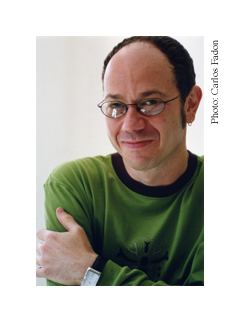Nationality Brazilian-American Name Eduardo Kac | Role Artist Period Contemporary art | |
 | ||
Awards Ars Electronica Golden Nica in the Category of Hybrid Art (2009) for his work "Natural History of the Enigma." Books Telepresence and Bio Art, Life extreme, Luz & letra | ||
Eduardo kac transgenic artist
Eduardo Kac [ɛdwardoʊ kæts; ĕd·wâr′·dō kăts] is a contemporary American artist and professor of Art and Technology Studies at the School of the Art Institute of Chicago. Kac was born in 1962, in Rio de Janeiro, Brazil. Kac has worked in numerous and diverse artistic media since he began practicing in the early 1980s in Rio. "His work encompasses many genres, and he is often a pioneer and a protagonist in many fields: holography applied to the arts, the creation of works to be transmitted by fax, photocopied art, experimental photography, video, fractals, digital art, microchips approached as human prostheses, virtual reality, networks, robotics, satellites, telerobotics, teletransportation, genomes, biotechnology, Morse code, DNA. Kac has coined many names for his work, such as: bioart, biopoetics, biorobotics, biotelematics, holopoem, holopoetry, telempathy, plantimal, telepresence, teleborg, transgenic art, weblography, and webot." In 2002 he received the Creative Capital Award in the discipline of Emerging Fields.
Contents
- Eduardo kac transgenic artist
- What if art could truly create biological life eduardo kac tedxvienna
- As an artist
- GFP Bunny
- References

What if art could truly create biological life eduardo kac tedxvienna
As an artist

Kac considers himself a "transgenic artist," or "bio artist," using biotechnology and genetics to create provocative works that concomitantly explore scientific techniques and critique them. Kac's first transgenic artwork, titled "Genesis"' involved him taking a quote from the Bible (Genesis 1:26 - "And God said, Let us make man in our image, after our likeness: and let them have dominion over the fish of the sea, and over the fowl of the air, and over the cattle, and over all the earth, and over every creeping thing that creepeth upon the earth"), transferring it into Morse code, and finally, translating that Morse code (by a conversion principle specially developed by the artist for this work) into the base pairs of genetics.

After obtaining the genes from a laboratory which creates genetic sequences on demand, he implanted the genes into e.coli bacteria, which he then grew in a petri dish. This petri dish was placed in a box under an ultraviolet light (UV) which could be activated by online viewers, who could see Genesis by webcam. Kac intended to present the viewer with a philosophical problem, a dichotomy: If the viewer disagrees with allowing man to have dominion over nature as the quote from the Bible suggests, then in order to destroy the idea (i.e. activate the UV light which causes mutation in the genes, thereby altering the statement), he must assert his own power over nature, thereby in a way contradicting himself. A viewer with the opposite viewpoint would have the opposite but equally problematic dilemma.
GFP Bunny

In what is probably his most famous work, Alba, Kac allegedly commissioned a French laboratory to create a green-fluorescent rabbit; a rabbit implanted with a Green Fluorescent Protein (GFP) gene from a type of jellyfish. Under a specific blue light, the rabbit fluoresces green. In 2000, Alba was presented in Avignon, France. Kac's aim was for Alba to live with his family, but prior to the scheduled release of Alba to Kac, the lab retracted their agreement and decided that Alba should remain in the lab.
GFP plants, fish, and mammals have been long-term residents of science laboratories. The GFP gene is typically used as a type of marker, that, when attached to a separate genetic modification or gene, illustrates where that symbiotic gene manifests in the organism. However, Kac used GFP as a social marker, in a symbolic (not scientific) manner, to raise questions about how society constructs the idea of difference. Notably, since Alba's conception, GFP zebrafish have hit the commercial market under the trademarked name, GloFish.
Kac, in response to the laboratory's retraction of Alba's liberty, flies a flag outside of his home, sporting a silhouette of a green rabbit.
